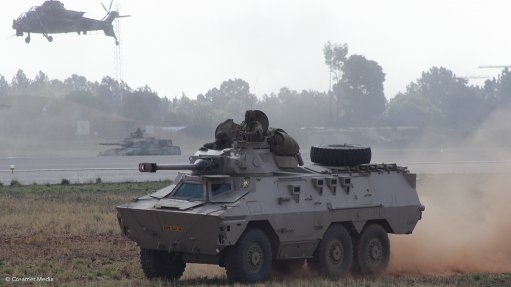
SANDF demonstration: a Ratel 90 fire support vehicle in the foreground, with a Rooivalk combat support helicopter overhead and a Rooikat armoured car in the background
Photo by: Creamer Media's Donna Slater
Parliament’s Joint Standing Committee on Defence has called for continuing dialogue on the nature of the defence force that the country wanted and needed. This had to be decided in relation to the budget required to maintain the desired force. This statement was issued following a mini-symposium on the design of, and related issues concerning, the South African National Defence Force (SANDF).
“This dialogue was necessary to isolate pertinent issues in our work of oversight over the SANDF, especially in relation to the fiscal constraints within which the SANDF operates and the state of the SANDF, as articulated by the defence review,” affirmed Defence Committee co-chairperson Cyril Xaba. “We appreciate the contributions made by invited experts Prof Lindy Heinecken, Dr Moses Khanyile and Mr Helmoed Heitman in dissecting challenges faced by the SANDF.”
A most important issue brought up by the panellists was the need to establish a national consensus regarding the funding of the SANDF. Currently, there was a misalignment between what was required of the SANDF and the budget allocated to the force. This situation existed against the background of a weak national economy.
“In relation to personnel, various views were expressed on the balance between short-, medium- and long-service, which has led to an imbalance between the SANDF’s deployable force and administrative bodies,” reported the committee in its statement. “Similarly, the lack of an exit mechanism contributes to an increase in personnel costs, which is exacerbated by rank inflation. The experts agreed that a robust conversation is needed on the ideal exit mechanism in South Africa’s situation and the funding of those mechanisms.”
The experts also agreed that some elements of the SANDF were performing well. However, “massive challenges” remained and the “gaps” that prevented the force from functioning optimally had to be urgently filled.
The committee itself has agreed that addressing the problems identified by the experts would require long-term planning, if the SANDF was to be made fit for purpose. Consequently, the committee resolved that the SANDF leadership must consider the ways to overcome these weaknesses, in the short-, medium- and long-terms.